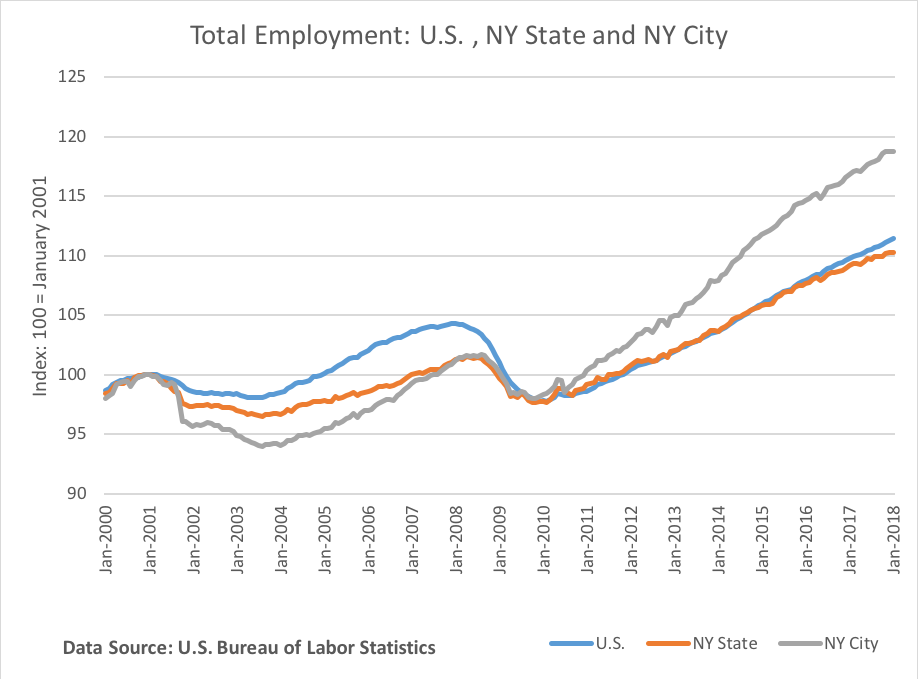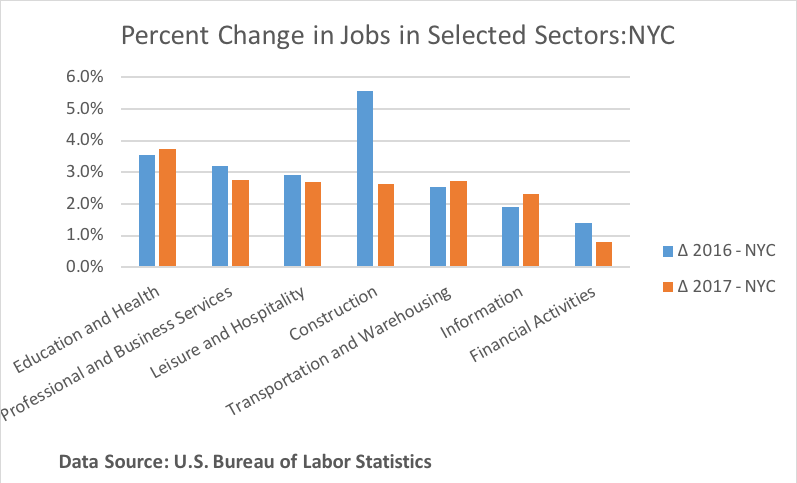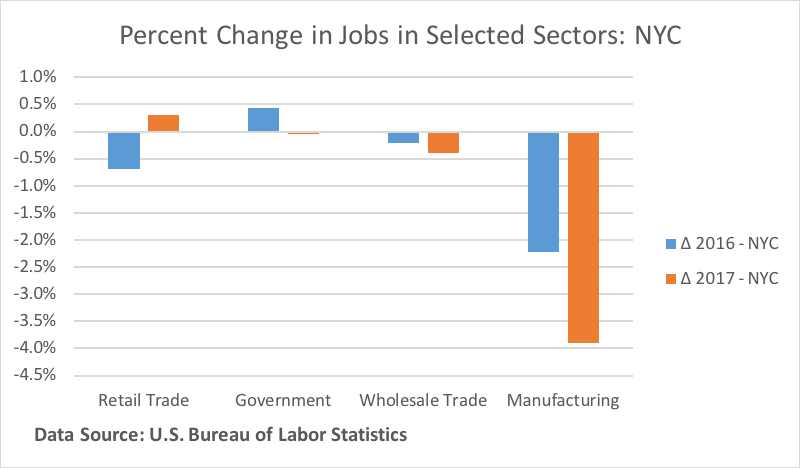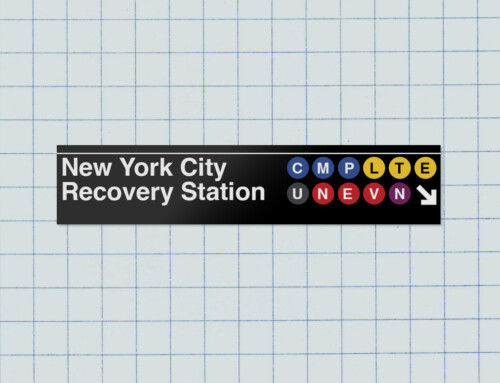James Orr
March 27, 2018
Recently-released employment data show job growth in New York City in 2017 was down only mildly from its pace in 2016 and is still above the comparable nationwide rate. On an average annual basis, employment in New York City expanded 2.0 percent in 2017 following a gain of 2.1 percent in 2016; these city growth rates, however, fall short of the 3.0 percent job growth rate in the city in 2015. For the state as a whole, job growth rates in each of the past two years were below those of the city and also slightly below the national rate, a pattern that has held for much of the roughly eight year period since the recovery of employment in New York got underway. This post examines these state and city employment trends and highlights the recent job performance in key sectors making up the New York City economy.
Employment Trends in New York City and New York State
The recovery of employment in New York City from the downturn and financial crisis began in late 2009 and has been quite strong compared to the nation. The figure below, also presented here, shows the robust recovery of employment in the city relative to both the nation and the state in this recovery. Job growth in the city had shown some weakness in late summer 2017, as discussed in an earlier post, but subsequent gains helped the city achieve healthy growth, 2.0 percent, for the year as a whole. In terms of job counts, the city added about 85,000 jobs in 2017 compared to just under 90,000 in 2016. The figure also indicates a declining rate of job growth in the past two years relative to the strong gains seen in 2014 and 2015 which roughly matched or exceeded 3.0 percent. In 2015, for instance, the city added 123,000 jobs. A measure of economic activity in the city also shows a pattern of strong though gradually slowing growth over the past several years.
Statewide, the recovery of employment has generally not been as strong as in the city. In 2017 job growth in the state was 1.3 percent, slightly below its 2016 pace and below both the city’s growth and the 1.6 percent job growth in the nation. As has been discussed previously, this disparity in growth across areas in New York State has persisted for some time and reflects the relatively slower pace of employment growth in the metropolitan areas in upstate and western New York. The more rapid job growth in downstate areas was again seen in 2017, though it should be noted that growth continued at a relatively strong pace in the Albany area and, after slipping for much of 2016, growth picked up in the Buffalo area.
Performance of Key Sectors in New York City
The relatively healthy overall job growth in New York City in 2017 reflects the net effects of growth in the diverse sectors that make up the city’s economy. The figure below shows the annual average job growth rates in 2016 and 2017 in the sectors making major positive contributions to growth.
Among the sectors, annual average job growth in 2017 was strongest in three of the city’s largest services sectors—education and health, professional and business services, and leisure and hospitality. Nationwide, these sectors also were high performers in 2017, with annual growth rates for each at 2.0 percent or more. The education and health sector in the city increased its growth rate over 2016 led by continued strong expansion of jobs in the health component. Growth rates in both the professional and business services and leisure and hospitality sectors in the city, however, were slightly off their 2016 rates.
Job growth was also high in the construction sector which reflects, in part, the continued high growth of residential building permits in the city. While strong, growth in the sector was off its 5.6 percent pace in 2016.
The information and transportation and warehousing sectors made relatively strong contributions to job growth in 2017 and both sectors expanded moderately faster than in 2016. Developments in the transportation and warehousing sector has been linked to the evolution of shopping trends, specifically, the decline in employment in traditional department stores and the corresponding rise of online shopping. The increasing demand for storage and delivery of items bought online likely is related to the changing nature of consumer shopping, a nationwide trend that is playing out in New York City.
Employment in the city’s financial activities sector, which includes the securities sector (Wall Street), banks, insurance companies and real estate firms, expanded by 0.8 percent in 2017, down from its gain of 1.4 percent in 2016. Jobs in the securities component were essentially flat in 2017 after rising by about 4,000 in 2016. Jobs here account for a little less than 5.0 percent of city private sector jobs but it has an outsized role in the city’s economy as the sector accounts for a little over 20 percent of private sector earnings. These high earnings gives the sector an important role in supporting demand and in city and state tax revenues.
The figure below shows annual average job growth rates in 2016 and 2017 in the sectors with weaker or negative contributions to job growth.
The retail trade sector in the city had modest job gains in 2017 following losses in 2016 and, as noted above, growth in the sector has been constrained to some extent in recent years by the shift of consumers to online shopping. In fact, the level of overall retail employment in the city has been fluctuating around 350,000 each year since 2014. Job growth in the government sector was flat in 2017 following a slight gain in 2016, mirroring national trends. Local government employment is the largest component of the sector in the city and current employment totals there remain roughly at the level they reached just prior to the downturn in the city’s economy.
Wholesale trade employment in the city saw modest declines in 2017 following an essentially flat performance in 2016. Jobs in the wholesale trade sector, as with retail trade, have been not expanding in line with the city’s generally robust job performance and the level of employment has been fluctuating around 145,000 since 2014.
The city’s manufacturing sector had a significant decline in jobs in 2017, losing 3.9 percent of employment, following a decline of 2.2 percent in 2016. As in the nation, this sector in the city has been experiencing secular declines in employment and job counts are down by about 20,000, or roughly 26.0 percent, over the past ten years.
Looking Ahead
The recent employment picture in the New York City economy is one of fairly healthy growth though the pace has slowed from the relatively high rates of previous years. Two reports project that this gradual slowing in the rate of overall city job growth will continue over the next several years. It is likely that the three major services sectors in the city that have been key drivers of job growth–education and health, professional and business services and leisure and hospitality—will continue to be sources of new jobs going forward. Some offset to these gains could come from further declines in the city’s retail trade and manufacturing sectors.
One factor that can be expected to influence the city’s job growth is the performance of the national economy. Projections have economic growth picking up a bit in 2018 over its 2017 pace but then slowing modestly through 2020. A risk to the outlook is that the national economy expands less than expected and thus weighs down city employment growth. Another risk arises from the provision in the recently-passed Tax Cuts and Jobs Act of 2017 which limits the size of the individual federal deduction for state and local tax payments. It remains to be seen what the consequences of this legislation will be for the state and city economies.









